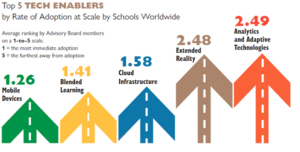The 2019 K12 Driving Innovation: Tech Enablers report, after multiple rounds of Delphi-like voting by expert panelists, has a lot to say about innovation-enabling factors specific to the educational marketplace. According to the report, tech enablers “are supporting tools that smooth the way to more expansive opportunities and solutions in education”. Personally, I have an extended view about what a tech enabler is.

I prefer to view ‘enablers’ as fertile soil that enables a company’s technology to take solid root, to sprout and grow, and not just wither away at the sight of the “next shiny object”. Overall, the panelists in this report wrestled with twenty-seven distinct tech enablers, narrowing down their list to five critical enablers of innovation. The chart below demonstrates the rate of adoption at scale for each of these enabler categories:
In this last in my series of three articles we will dwell on the five enablers that, according to the Driving K12 Innovation expert panel, will enable ed-tech adoption to grow deeper roots, be sustained over time and flourish. The full tech enablers report can be accessed here.
Although the Driving Innovation: Enablers 2019 report largely speaks for itself, in this piece I will offer a bit of translation and connection. With full disclosure, I must mention that I served as one of the 111 world-wide panelists who developed this report over many months. The expert panelists included “included leading members of CoSN’s Emerging Technologies Committee, as well as leaders from key U.S. and international education organizations and ministries of education”. Serving as a panelist for the report for the last six years (Driving K–12 Innovation is the successor to the New Media Consortium’s Horizon K–12 reports, a decade-long series that ended in 2017), I can add beneficial nuance to the findings, from an inside perspective. Let’s take a quick look at five recognized innovation enablers:
Mobility Devices
Mobility learning tools continue to provide fertile soil for technology innovation in schools. According to the report, these devices “enable access to knowledge and creative activities anytime, anywhere. {They also] support global connections, self-curated content and personalized learning”. The report also highlights the notion that “schools around the world are using mobile devices to try to address digital equity issues”, making further technology growth possible.
Blended Learning
Blended or hybrid learning involves a mix of face-to-face instruction and online learning. According to the report, blended learning permits “a more personalized learning experience”, diversifies often tedious and redundant learning experiences, and gives learners greater autonomy “to learn in ways that suit their preferences”. Blended learning is a major theme at every educational conference these days, one that truly provides arable soil for furthering tech innovation along its upward trajectory.
Cloud Infrastructure
Cloud infrastructure, already well known to the business environment, provides exceptionally productive soil for moving innovation forward in schools. According to the Tech Enablers report, it makes teaching and learning resources readily available in any location. And, when done right, it can go a long way towards reducing server, end user device, and maintenance/repair costs. The explosion of Chromebook technologies in schools today is apt evidence.
Extended Reality (XR)
The fourth tech enabler identified in the report is Extended reality (XR) or augmented, mixed and virtual reality. The report explains that “educators are beginning to use these technologies to help students learn complex content and to provide experiences otherwise impossible due to funding, geography or physical challenges”. I am not sure XR is a true ‘enabler’, fruitful soil for furthering other innovations along, but it is certainly verdant, or popular, these days.
Analytics/Adaptive Technology
The final enabling technology mentioned in the report is actually a loosely connected duo. Data analytics help “track student performance and other indicators of student success”; adaptive technologies employ analytics to “serve up tailored content that reinforces and propels learning”. As I have stated in previous writings, analytics is a true enabler for display technologies, which is good news.
One notion that should be increasingly clear is that most of the tech enablers described above do not stand on their own. Rather, their effectiveness or fruitfulness depend upon the relationships teachers build with students and the particular expertise teachers bring to the table in the educational setting. Teachers will have a strong voice in how these play out. –Len Scrogan

